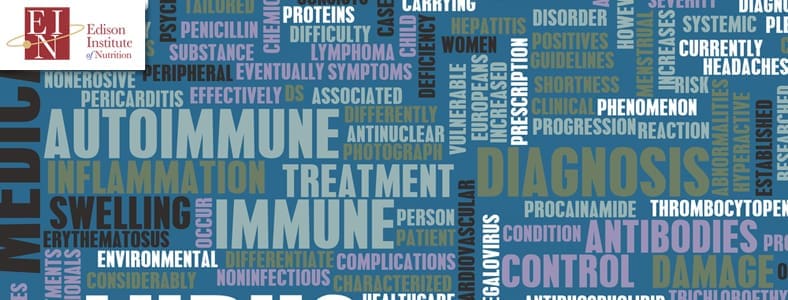
How To Use Nutrition To Fight Autoimmune Conditions
At Edison Institute of Nutrition, we recognize that people can use proper nutrition for a wide variety of health concerns. After graduating with your diploma in holistic nutrition, you will share in that knowledge. A major concern is autoimmune conditions. A proper nutrition plan with diet, supplements, and lifestyle modifications can correct the underlying causes of autoimmune conditions and regulate the inappropriate immune responses.
What Is An Autoimmune Disease?
An autoimmune disease occurs when your immune system misidentifies perfectly healthy parts of your body as a threat and attacks them. Normally, a healthy immune system acts as a protector against viruses and bacteria by releasing proteins called antibodies to fight them.
Autoimmune diseases are a grouping of disorders that cause your body to point fingers in the wrong direction, and the damage can be life altering. Not every autoimmune disease is the same. Some will only target a specific organ, while others will send fighter cells to multiple areas of perceived concern. Despite the differences in targets, many autoimmune disorders share similar early symptoms. Some autoimmune diseases exhibit unique symptoms that fluctuate from mild to severe.
Early symptoms of an autoimmune disorder may include:
- A low grade fever
- Skin rashes
- Hair loss
- Achy Muscles
- Chronic fatigue
- Tingling and numbness in hands and feet
- Issues with concentration
- Pain and swelling of tissues
What Causes Autoimmune Diseases?
While the exact cause of autoimmune diseases is still uncertain, researchers have been able to identify some common risk factors and patterns among them. Families that have a history of conditions like lupus and multiple sclerosis pose a higher risk of developing an autoimmune condition. The specific autoimmune disorder may be different, but the chance of an autoimmune disorder, in general, is higher.
Furthermore, researchers have found that cisgender women in their childbearing years (15 to 44) are almost twice as likely to develop an autoimmune disease as their male counterparts. In recent years, researchers have noticed a growth in the number of people with autoimmune diseases. As a result of this observed growth, researchers have begun to investigate environmental factors such as EMF’s, chemical and metal exposure, and the “Western diet”.
On average, people in North America have a diet that is high in fat, particularly trans fats and sugar, and researchers are curious as to whether this is correlated with the rise in autoimmune disease cases. When it comes to autoimmune research, we need many more answers about how and why they develop.
Autoimmune conditions are linked to toxins including chemical/metal exposure, genetics, diet, improper sleep pattern, over excerising, stress, and bacterial, viral and fungal infections. A holistic nutritionist will evaluate all underlying cause and effect possibilities that may contribute to an autoimmune condition.
What Are The Most Common Autoimmune Diseases?
As of today, researchers have identified more than 80 different autoimmune disorders. In the interest of keeping this page from turning into a novel, we have focused on five of the most common autoimmune diseases.
1. Diabetes and Nutrition
Diabetes is an autoimmune disease, where your immune system seeks out and destroys cells that produce the hormone insulin in the pancreas. Insulin is integral to your body’s ability to regulate blood sugar. High levels of blood sugar can cause damage to your heart, kidneys, blood vessels, eyes, and nerves. If left unchecked, Diabetes can be fatal.
Using Nutrition To Fight It
While you can’t cure Diabetes Type 1 through healthy eating, you can greatly reduce its impact on your body. Healthy eating, however, can make a huge impact on Diabetes Type 2. Because Diabetes affects your body’s reaction to blood sugar, and your blood sugar is impacted by your food intake, many physicians suggest developing a meal plan.
A Diabetes meal plan is often centered around two main factors: regular mealtimes, and the monitoring of carbohydrates, protein, fat, and sugars. By planning what times you eat your meals you can get a better handle on when your blood sugars will spike. Monitoring your protein, fat, carbohydrate, and sugar intake will also help to balance insulin. We understand that crafting a Diabetes meal plan can be overwhelming, so below is a quick guide on what foods you may want to work into your diet:
Healthy Carbohydrates
Healthy carbohydrates include vegetables, fruits, whole grains, and legumes.
Fibre Rich Foods
High fiber foods such as legumes, fruits, vegetables, whole grains, and nuts and seeds can help your body’s digestion and aid in monitoring blood sugar levels.
Heart Healthy Fish
Fish that are rich in omega 3 fatty acids such as organic salmon, mackerel, and sardines all reduce the risk of heart disease. Tuna is not recommended due to the high mercury content. Heart disease is a common comorbidity with Diabetes.
Healthy Fats
Foods such as avocados, olive oil, and nuts have both polyunsaturated and monounsaturated fats, which can help to reduce your cholesterol levels.
What To Avoid
Moderation is the key to any nutrition plan, and as you add more healthy foods to your diet you must consider what unhealthy foods you should leave behind.
Diabetes puts you at risk for developing heart disease, high blood pressure, and stroke, so you want to reduce your consumption of artery clogging components, such as:
Trans Fats
These include processed foods, baked goods, and food with high margarine content.
Sodium
Foods with high sodium content should be avoided. This is especially true of table salt, which includes most processed foods.
Cholesterol
The type of cholesterol that’s harmful is LDL cholesterol, also known as “bad cholesterol”. HDL cholesterol, on the other hand, is beneficial.
Overall
By reducing foods that clog your arteries and spike your sugar levels, your body can work better with the insulin it produces or that you medicate with.
2. Psoriasis and Nutrition
Psoriasis is when your skin cells multiply faster than the average person. Those extra skin cells build up and create red patches with scales on your skin. Left unattended, these inflamed patches can lead to stiffness, pain, and swelling in your joints. When joint pain becomes an issue, psoriasis becomes psoriatic arthritis.
Using Nutrition To Fight It
If you deal with psoriasis in your life, you may already monitor your stress levels, take medication, and even track the weather. But did you know that watching your nutrition can also be a useful tool for reducing skin irritation?
Determining food sensitivities with lab testing (holistic nutritionists can help with this) and doing a food elimination diet specific to your individual needs may help with many symptoms. Certain foods have been known to help reduce inflammation in the body, and since psoriasis is an inflammatory condition, there may be a link. And frankly, there isn’t a single health practitioner in the world who would be opposed to you eating a healthier diet!
Specific nutrients, vitamin C, vitamin E, selenium, zinc, vitamin A and beta carotene all heal skin and are anti inflammatory and help make an impact. Others have been turning their attention to the fatty acids found in fish oil. High EPA in fish oil is anti inflammatory.
If you’re looking to create a meal plan that may help with your psoriasis symptoms, many people with the condition suggest incorporating anti-inflammatory foods such as:
Omega 3 Rich Foods
These include sardines, organic salmon, and organic eggs.
Herbs & Spices
Particularly those that have antioxidant properties, such as ginger, sage, thyme, and cumin.
Plant Based Foods
Leafy greens, vegetables, and fruit, berries, in particular, are highly recommended. As well, consider seeds, nuts, olive oil, and other heart healthy fat sources.
Foods To Avoid
Avoid foods that trigger inflammation, such as:
- Dairy products
- Red meat
- Refined sugars
- Processed foods
Overall
Please keep in mind that you need to listen to your body as you make these changes. Psoriasis has different triggers for each person. While a friend of yours may have found that a certain food made their condition better, you may notice that this is not true for you. If your skin ever gets worse after eating a particular food, try cutting it out for a while and then reintroducing it to see if it is a trigger for you.

3. Celiac Disease and Nutrition
Celiac disease is an autoimmune response to gluten in your body. When your body has this negative reaction to eating gluten, it can damage the hair like follicles located in your small intestine. These follicles are called microvilli, and they play a major role in the absorption and distribution of nutrients throughout your body. When your microvilli become damaged, it can cause you to become nutrient deficient and anemic.
Common symptoms include:
- Abdominal pain
- Vomiting and nausea
- Constipation
- Weight loss
- Diarrhea
- Gas and bloating
Less common symptoms include:
- Fatigue
- Headaches
- Mouth ulcers
- Joint pain
- Anemia
- Itchy and blustery skin
- Numbness in the feet and hands
- Balance issues
Using Nutrition To Fight It
Most people know celiac as the disease that prevents you from eating gluten. Naturally, people with celiac must stick to a strict gluten free diet. But did you know that treating celiac is not only about taking gluten out of your diet?
It is also crucial for you to add replenishing nutrients into your system to repair the damage in your small intestine. By eating nutritional food and creating a meal plan that is conscious of your gut health, you can help manage the symptoms of celiac and repair the damage from it. Approaching celiac and nutrition can look different than other meal plans because you must factor in resting times for your digestive system.
That is why we have outlined commonly suggested approaches to nutrition and celiac as opposed to simply a list of foods to eat or not eat. Some commonly suggested approaches to nutrition and celiac include:
Green Juicing
Some people with celiac incorporate green juicing into their diet as a simple gluten free way to increase the nutrients in their body, without adding additional digestive strain.
Bone Broth
While being extremely easy to digest, bone broth delivers anti-inflammatory properties, minerals, collagen, and vitamins straight to where they need to be.
Intermittent Fasting
Fasting gives your digestive system a chance to rest and allows for your small intestine to repair itself. Different people fast for different periods of time, it’s important to talk to a qualified health professional about what level of fasting is healthy for you.
Please be aware that intermittent fasting can sometimes act as a gateway to disordered eating, and that’s not our goal. Intermittent fasting is just meant to be a minor break for your digestive system. For many, stopping eating after dinner at around 7 or 8pm and having breakfast 13 to 16 hours later works best.
Avoid Acidic Foods
Acidic producing food such as cheese, meat, and soda are hard for your stomach to digest.
Supplements
Adding supplements to your daily routine is a good idea for most people. If you’re dealing with celiac disease, recommended supplements include omega 3 fatty acids, vitamin D3K2, and vitamin B12.
Avoid Processed Foods
While some packaged gluten free food is healthy, others are made with GMOs, starches, artificial dyes, and preservatives.
Consider A Probiotic
Probiotics can help you raise the number of good bacteria in your gut.
Overall
There is no perfect food plan that works best for your celiac disease. Trial and error and keeping a food and symptom journal will help. As a registered holistic nutritionist graduate, it would be up to you to work out what works best for your clients.
4. Graves’ Disease and Nutrition
Graves’ disease is when your immune system attacks your thyroid gland and triggers the gland to make more hormones than it should. The hormones made by your thyroid are in control of how your body uses energy, also known as your metabolism. When you produce too much thyroid hormone your body goes into overdrive, and you may notice symptoms such as:
- A fast heartbeat
- Weight loss
- Nervousness
- Heat intolerance
- Bulging eyes –known as Graves’ ophthalmopathy
Using Nutrition To Fight Graves’ Disease
Graves’ disease is a form of hyperthyroidism, hyper implying that it makes your thyroid gland overactive. Many people with Graves’ disease center their diet around low iodine foods and cruciferous vegetables. Iodine is a nutrient that promotes thyroid hormone production, which is something that your body is already overdoing.
Foods such as fruit, eggs, oats, honey, and potatoes are low in iodine and safe for you to eat. Cruciferous vegetables are vegetables that prevent your thyroid from using iodine properly, which can slow it down to a normal rate for someone with hyperthyroidism. Some examples of cruciferous vegetables are broccoli, Brussels sprouts, kale, bok choy, mustard, and rutabaga.
If you want to go the extra mile, you may also want to incorporate some vitamins and minerals into your diet as they can help balance your thyroid hormone production. Some beneficial vitamins for those with Graves’ disease include:
Iron
Low iron levels are linked to hyperthyroidism.
Selenium
Selenium helps keep your thyroid healthy by preventing cell damage.
Zinc
Zinc aids your body in using food as energy and in keeping your immune system healthy.
Calcium And Vitamin D3K2
Hyperthyroidism can make your bones brittle. These two components are your secret weapon to fight that.
5. Hashimoto’s Thyroiditis and Nutrition
Unlike Graves’ disease, where your thyroid makes too many hormones, Hashimoto’s thyroiditis is a condition where your hormone production slows down to a deficiency.
This is a condition called hypothyroidism, and Hashimoto’s thyroiditis is the most common cause of it.
Common symptoms include:
- Weight gain
- Fatigue
- Hair loss
- Cold sensitivity
- Development of a goiter — a swollen thyroid
If Graves’ disease is one extreme of a thyroid hormone disorder, Hashimoto’s thyroiditis is the other.
Using Nutrition To Fight It
When it comes to hypothyroidism, as a registered holistic nutritionist, you should suggest vitamins and minerals from food as a preference to taking supplements. Be sure to include foods that are rich in iodine, zinc, and selenium.
In contrast to hyperthyroidism, where you want to avoid iodine because it increases your body’s use of the thyroid hormone, iodine is great if you deal with hypothyroidism. Each of these nutrients promotes production of thyroid hormones, which is the number one problem with this disease. You want to eat foods that give your thyroid hormone production a kick start.
However, it’s not all about adding new foods to your diet. You should also be aware of what foods you will need to cut back on. If a practitioner, advise your clients to avoid foods with a high sodium content. This is true for anyone’s diet, but especially for someone with hypothyroidism. Processed foods and foods that use salt as an extra seasoning are no longer your friend.
An underactive thyroid already puts you at risk for blood pressure issues. High sodium depletes potassium needed with hypothyroidism. Try exploring other herbs and seasoning that have a low sodium content. You may even discover a new favorite dish.
Long story short, if a vitamin is known to help boost the production of thyroid hormone, you want to eat it; lots of it. And if a food has a high amount of sodium, you want to avoid it; all of it.
Contact Edison Institute Of Nutrition Today
Are you interested in studying to become a registered holistic nutritionist?
If so, contact us for an appointment today.
